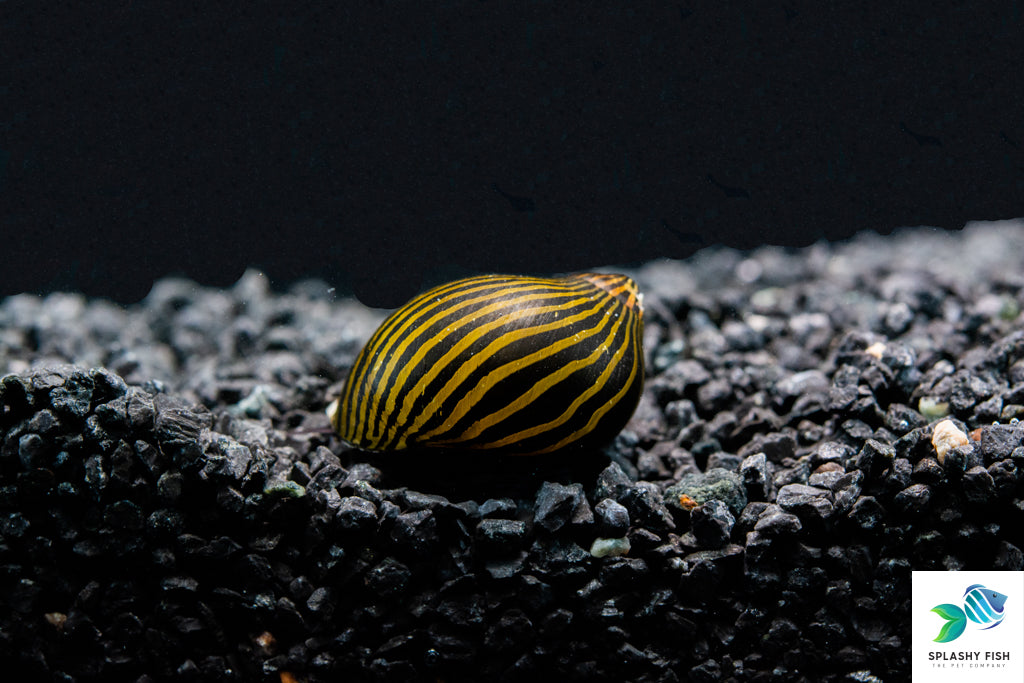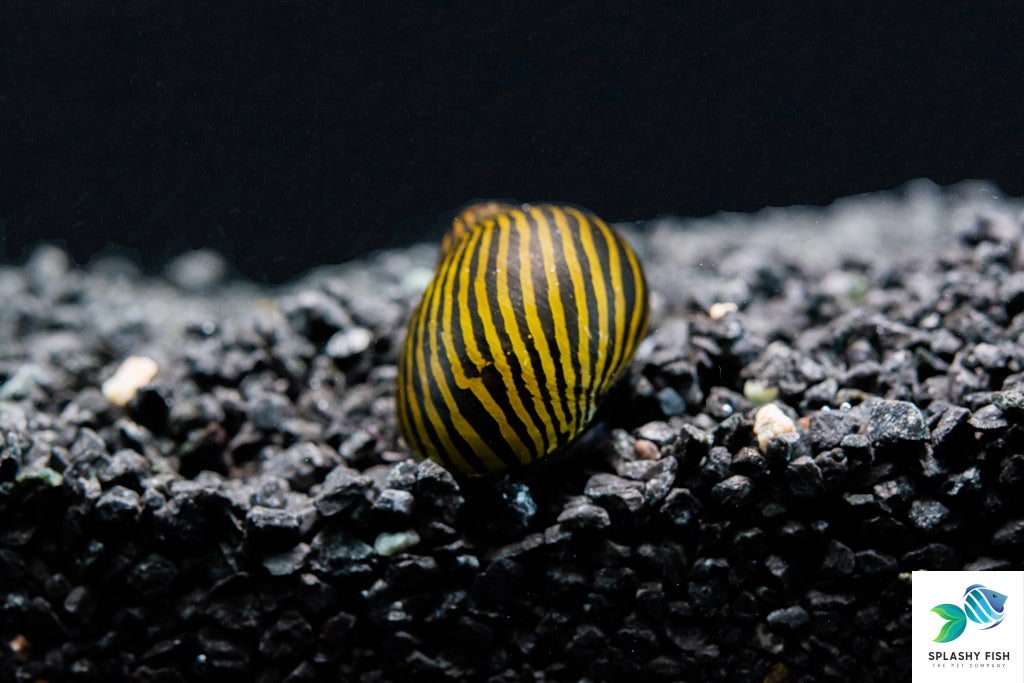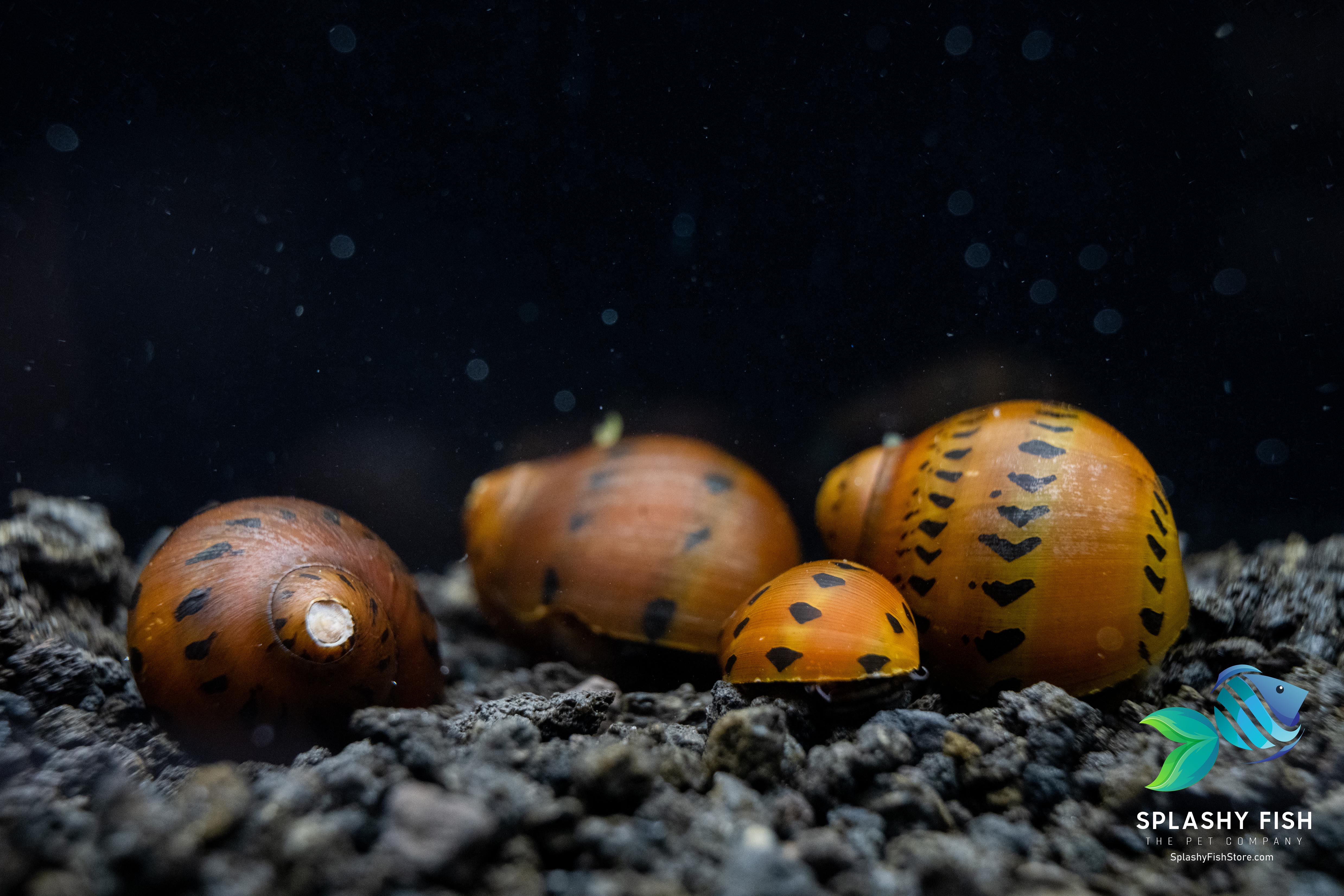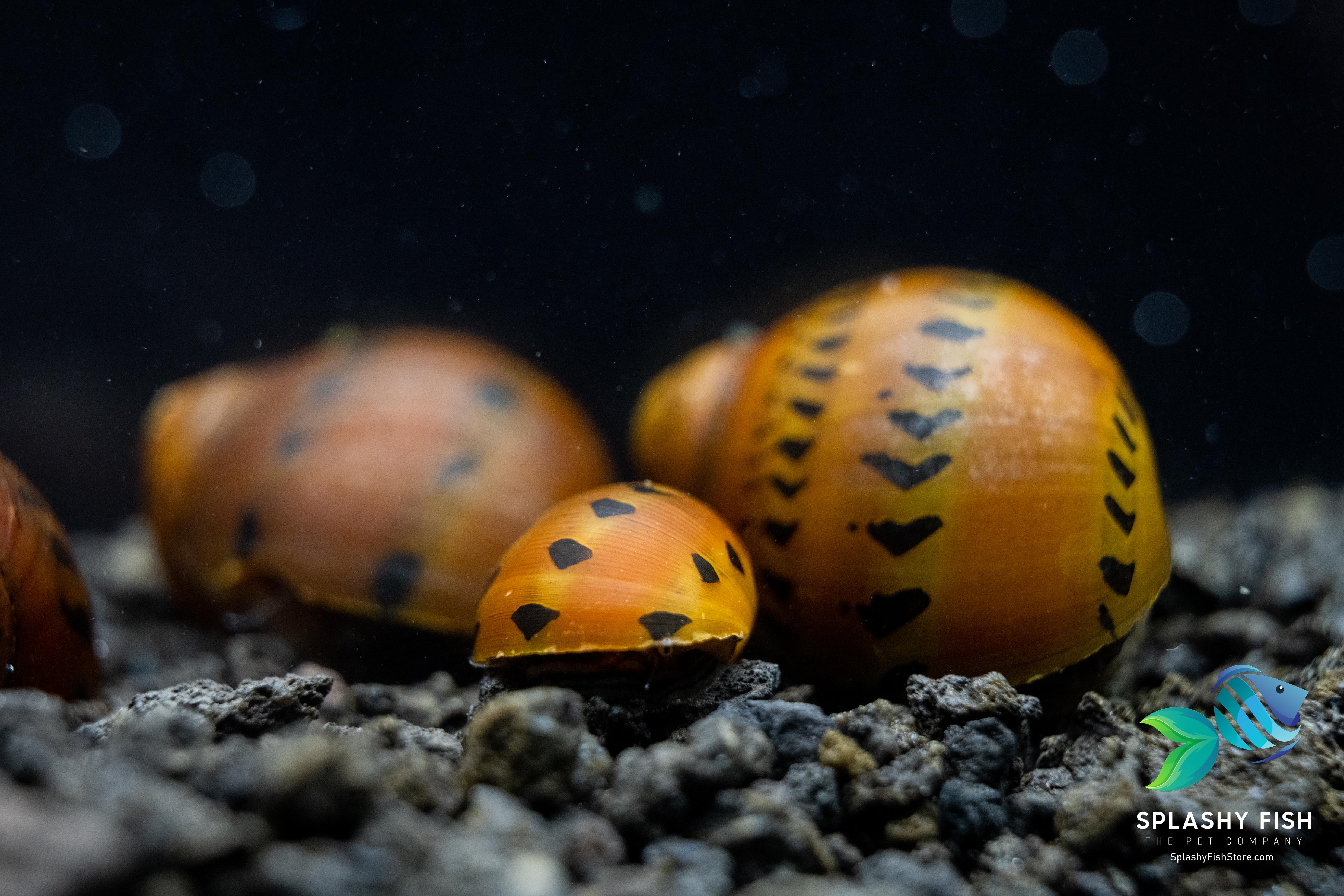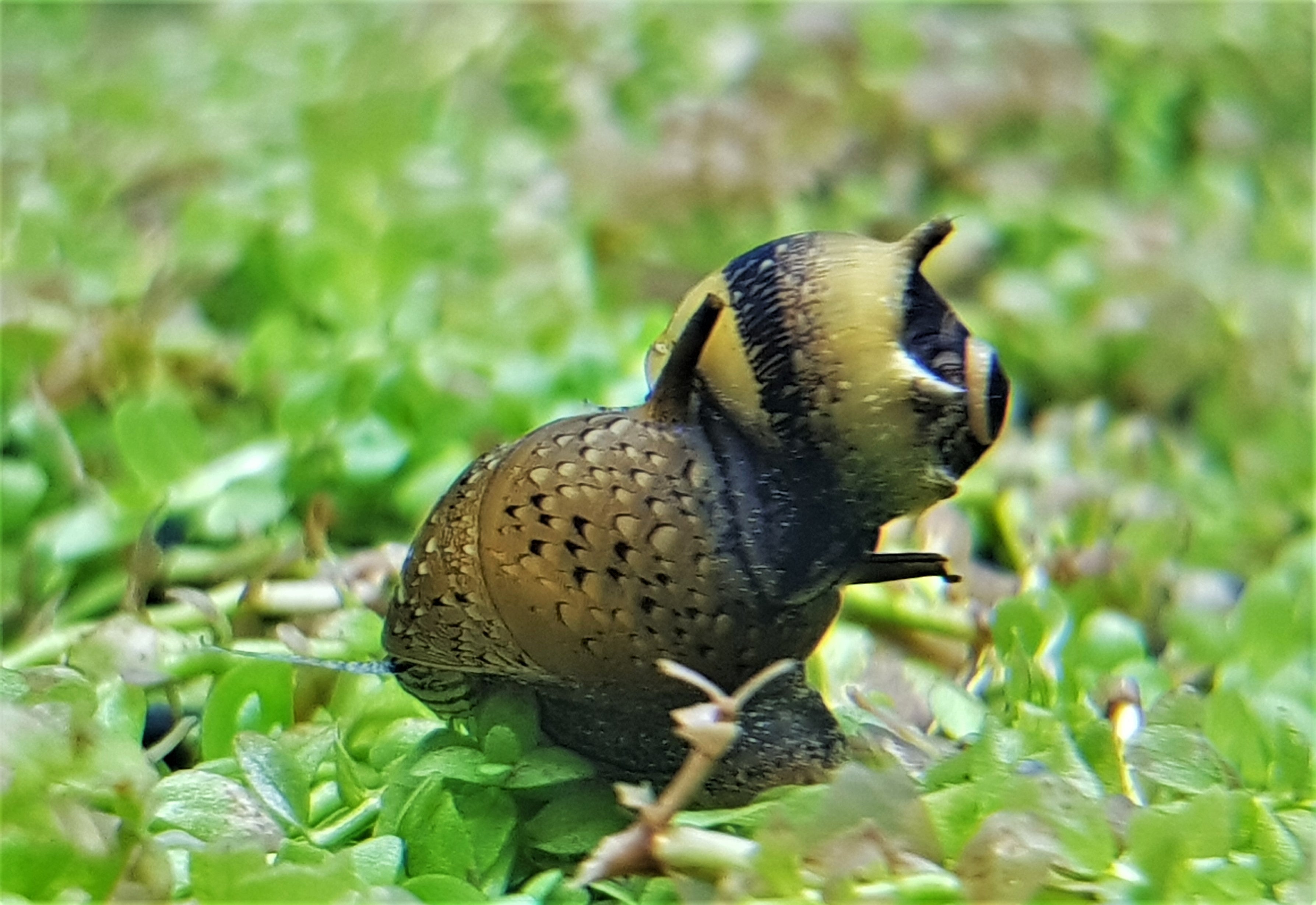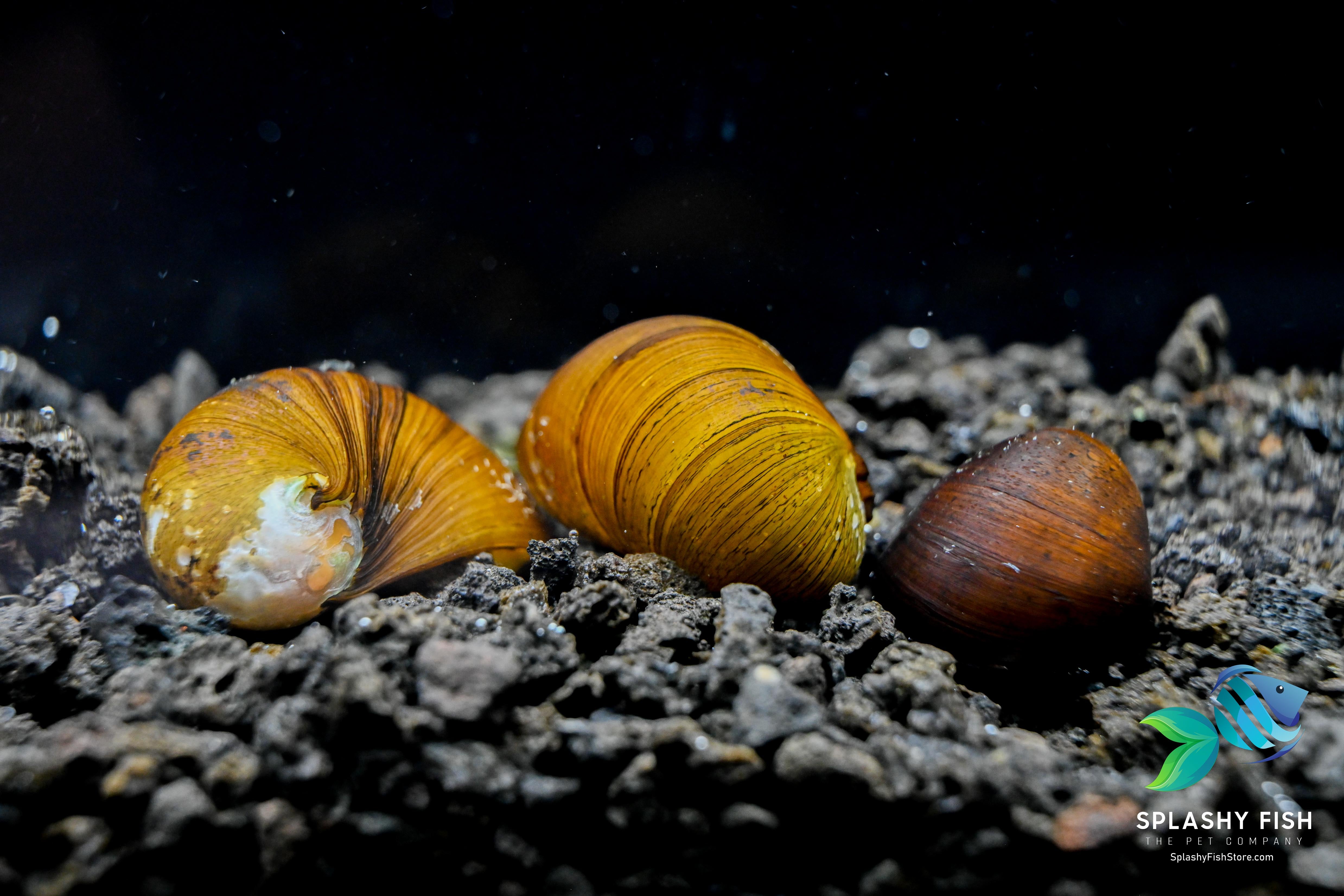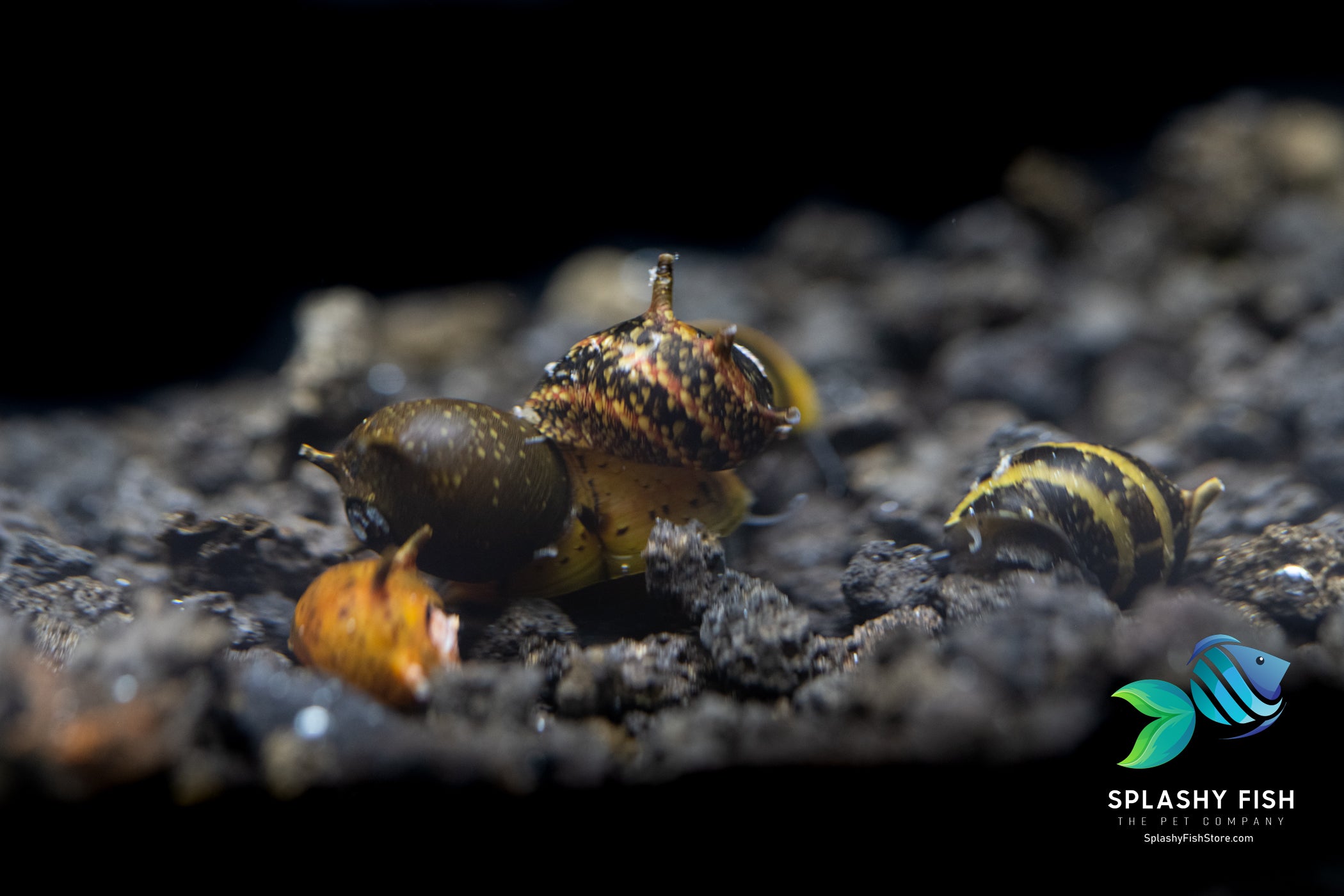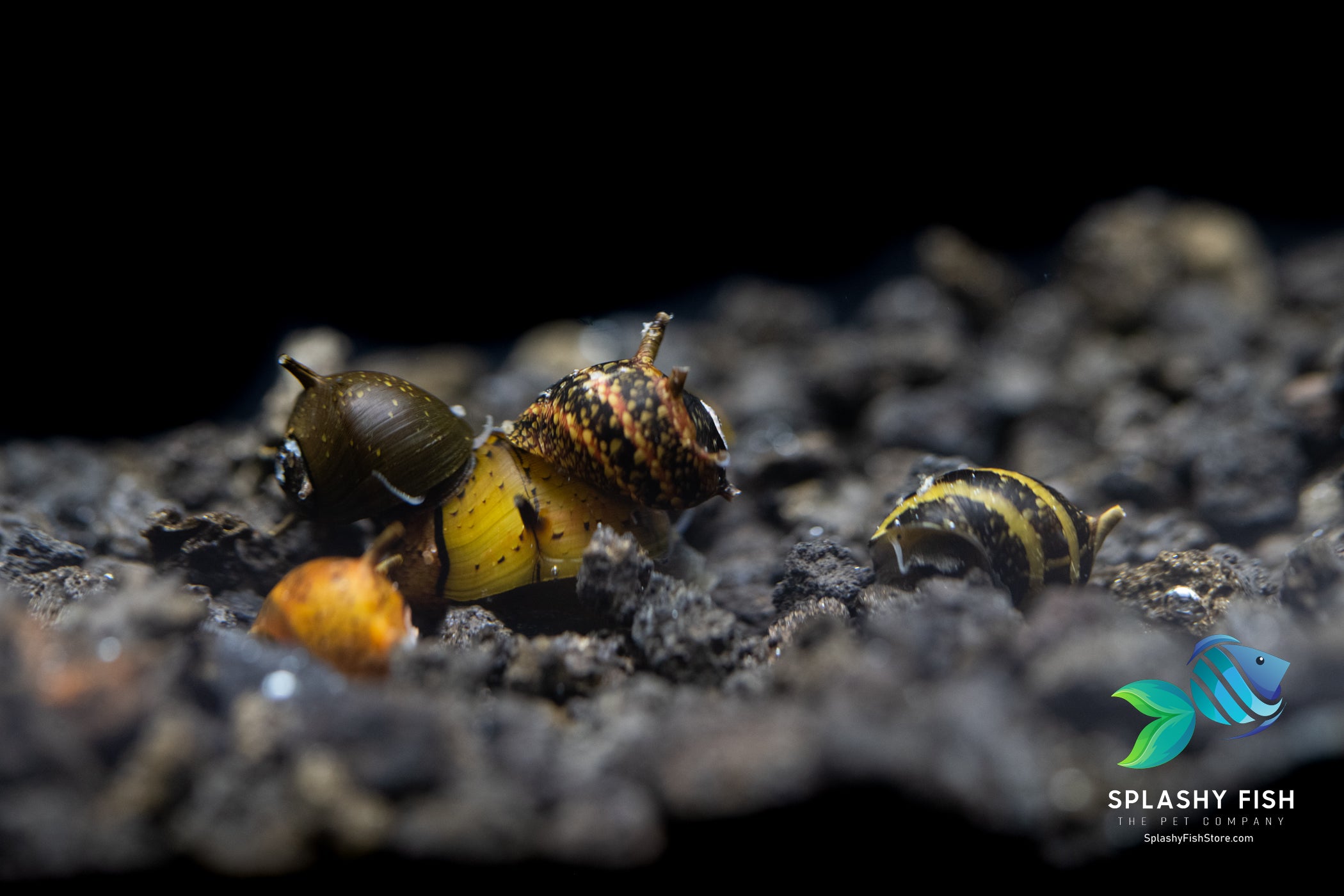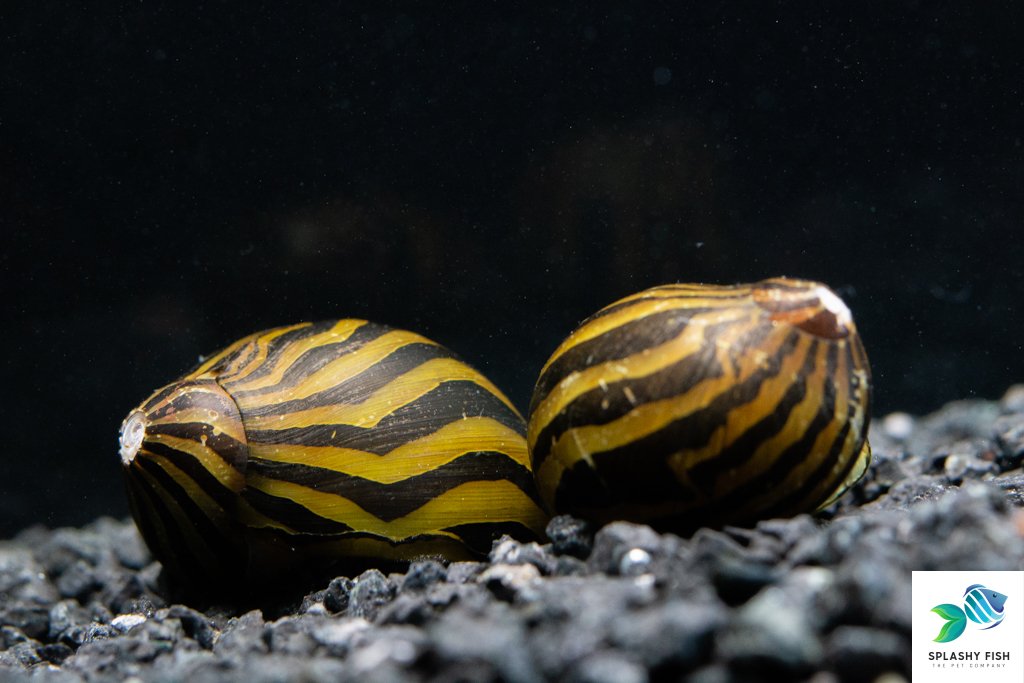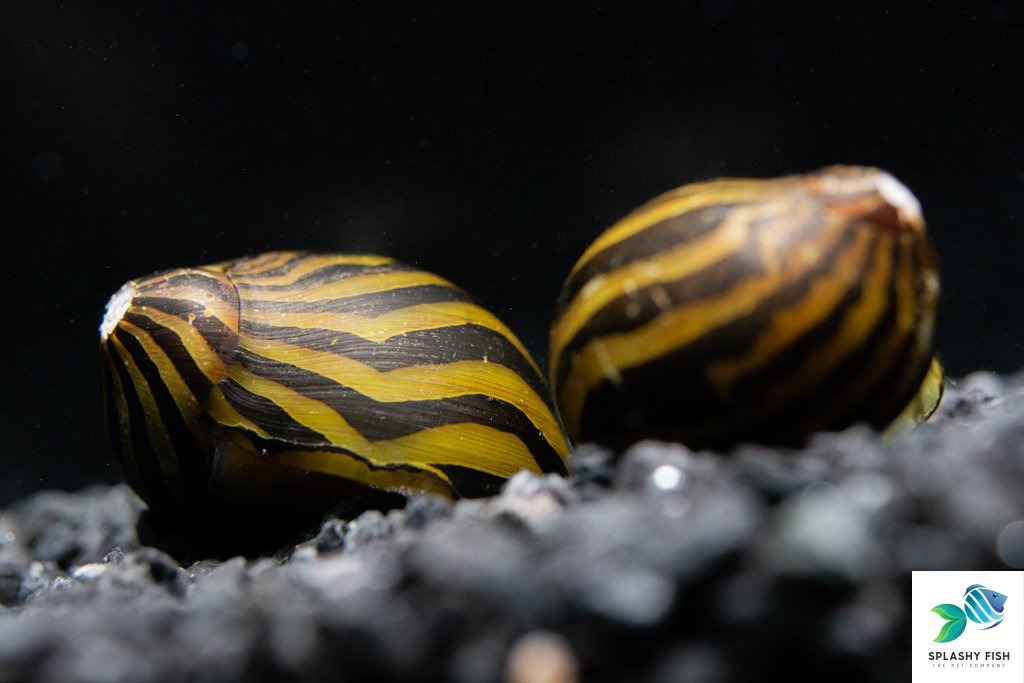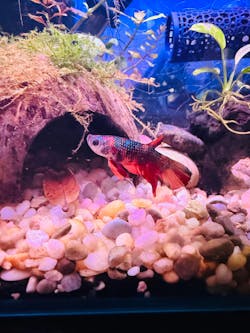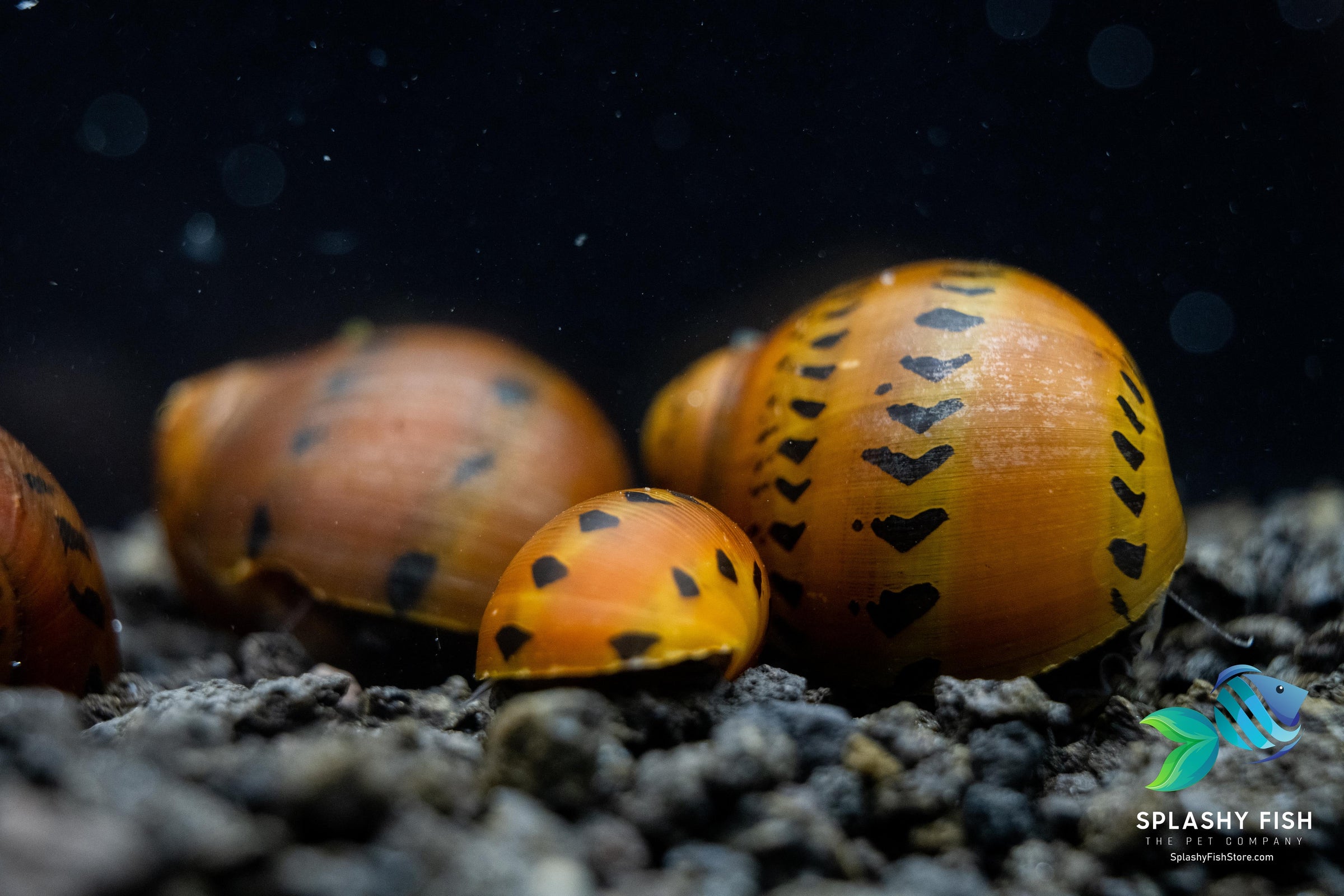
Nerite Snail
Nerite snails (Neritina spp.) are a highly sought-after choice for aquarium enthusiasts, admired for their vibrant, decorative shells and their ability to keep tanks clean. As one of the best algae eaters available, Nerite snails naturally reduce unwanted algae growth, making them an essential part of a well-maintained aquarium.
In addition to their aesthetic appeal, Nerite snails are hardy and relatively easy to care for, making them perfect for both beginners and experienced aquarists. These peaceful invertebrates thrive in freshwater and brackish environments, but it's essential to maintain proper tank conditions for their long-term health. A suitable tank setup includes plenty of hiding spots, well-oxygenated, clean water, and a reliable source of food. They happily consume algae, leftover fish food, and other debris, helping to keep your aquarium environment healthy.
Feeding your Nerite snail can be simple. Algae wafers, blanched vegetables, and sinking pellets are all suitable options. In tanks with limited algae, supplementing their diet ensures they remain healthy and active. Additionally, regular water changes and high-quality filtration are necessary to maintain optimal water conditions.
Whether you're looking for an algae control solution or want to add unique beauty to your tank, Nerite snails are an excellent choice. Their low-maintenance care requirements and hardworking nature make them a popular addition to any aquarium. Ideal for community tanks, these freshwater snails will help create a cleaner and healthier environment, benefiting both your live fish and your tank’s overall aesthetics.
Visit this article to explore more about How to Care for Nerite Snails.
At Splashy Fish Store, our Nerite Snails for sale are carefully hand-selected and quarantined before shipping to ensure the highest quality when the order comes to our customers. Visit us to buy these Nerite Snails online or at our aquarium store in Virginia for other freshwater snails for sale, freshwater shrimp for sale, freshwater fish for sale, and live aquatic plants for sale.
Types of Nerite Snails
- Zebra Nerite Snail: Features bold black and gold stripes, perfect for algae control and eye-catching tank aesthetics.
- Red Racer Nerite Snail: Rare and vibrant with reddish-orange shells and black racing stripes, ideal for collectors and planted tanks.
- Tiger Nerite Snail: Displays dark tiger-like stripes over a golden shell and actively grazes on algae in freshwater aquariums.
- Batik Nerite Snail: Known for its intricate tribal shell patterns, making it a unique decorative snail for nano and aquascaped tanks.
- Military Helmet Nerite Snail: Camouflage-style shell with a rugged look, excellent for rock-heavy or natural-style setups.
- Zebra Thorn/Horn Nerite Snail: Small and effective algae eater with horn-like shell projections and bold zebra striping, perfect for nano tanks.
Nerite Snails Frequently Asked Questions FAQs
Are Nerite Snails hardy?
Yes, Nerite Snails are considered hardy and easy to care for, making them an excellent choice for both beginner and experienced aquarists. They can tolerate a wide range of water conditions but thrive best in a stable environment with clean, well-oxygenated water. Regular water changes and proper filtration will ensure their health and longevity.
Can Nerite Snails live out of water?
While Nerite Snails can survive out of water for short periods, they are aquatic animals and require a submerged environment to thrive. They may occasionally climb out of the water, but it's important to ensure they don't remain out for too long as it can lead to dehydration or death. Always check your tank to prevent them from escaping or staying out of the water for extended periods.
What do Nerite Snails eat?
Nerite Snails are excellent algae eaters and will feed on various types of algae present in your tank. In addition to algae, they can also eat leftover fish food, blanched vegetables (such as zucchini or spinach), algae wafers, and sinking pellets. If your tank lacks enough algae, it's a good idea to supplement their diet to ensure they receive adequate nutrition.
The Ultimate Advanced Care Guide for Nerite Snails: Everything You Need to Know to Keep Your Aquatic Pets Healthy and Thriving
Are you the proud owner of Nerite snails in your aquarium? If so, you've come to the right place! In this ultimate advanced care guide, we will cover everything you need to know to keep your aquatic pets healthy and thriving. Nerite snails are fascinating creatures that not only add beauty to your tank but also provide various benefits, such as algae control and overall tank maintenance. However, providing them with the care they need can sometimes be a challenge, especially for beginners. From creating the perfect tank environment to ensuring the right water conditions, we will delve into all aspects of advanced care for Nerite snails. You'll learn about their dietary requirements, preferred temperature range, and the best tank mates to keep them stress-free. Additionally, we'll explore common health issues that may arise and provide tips on how to identify and treat them effectively. By following our expert advice, you can ensure that your Nerite snails lead a long, happy, and healthy life in your aquarium. Get ready to become a Nerite snail care expert with this comprehensive guide!
Origin
Nerite snails are native to coastal regions and can be found in a variety of environments, from brackish water to freshwater rivers and streams. They are particularly abundant in parts of Africa, the Caribbean, and the Pacific. Their adaptability to different habitats has contributed to their popularity in the aquarium trade, where they help maintain tank cleanliness by feeding on algae.
When considering Nerite snails for your tank, it's important to replicate their natural habitat as closely as possible. Understanding their origins will help guide you in creating the ideal environment that allows them to thrive.
Understanding the Unique Characteristics of Nerite Snails
Nerite snails come in a wide range of patterns and colors, such as the popular Zebra Nerite Snails, Tiger Nerite Snails, and Batik Nerite Snails. One of the key characteristics that make Nerite snails unique is their inability to reproduce in freshwater. While they lay eggs, the larvae require brackish water to develop, which is why overpopulation is never an issue in freshwater aquariums.
In terms of behavior, Nerite snails are peaceful creatures that prefer to graze on algae and biofilm. Their size typically ranges from 1 to 1.5 inches, making them suitable for both large and small tanks. However, their relatively small size makes them vulnerable to predators, so selecting the right tank mates is essential.
Setting Up the Perfect Habitat for Nerite Snails
Creating an ideal environment for your Nerite snails is one of the most critical aspects of advanced care. A well-thought-out habitat not only keeps them healthy but also allows them to perform their natural behavior, such as algae grazing.
Tank Size
While Nerite snails can live in small tanks (5 gallons or more), larger tanks provide more surface area for them to graze. Ideally, a tank of at least 10 gallons is recommended to ensure your snails have enough space to explore and find food.
Substrate and Decorations
Nerite snails love to roam across the substrate and decorations, so having a smooth, algae-rich environment is ideal. Soft sand or fine gravel works best for the substrate. Driftwood, rocks, and live plants not only enhance the tank's aesthetic but also provide surfaces for algae growth.
Filtration
Nerite snails are sensitive to poor water quality, so a strong filtration system is essential. Make sure your filter has gentle water flow to avoid stressing the snails. Regular maintenance, including water changes and filter cleanings, helps prevent the buildup of harmful substances like ammonia and nitrites.
Feeding and Nutrition for Nerite Snails
Nerite snails primarily feed on algae, making them one of the best natural cleaners for your aquarium. However, in a well-maintained tank, algae levels may not always be sufficient to meet their nutritional needs.
Algae-Based Diet
If your tank doesn’t produce enough algae, you can supplement their diet with algae wafers or blanched vegetables such as spinach, zucchini, or cucumber. Make sure to remove uneaten food to prevent water quality issues.
Calcium-Rich Diet
Like other freshwater snails, Nerite snails require calcium to maintain a healthy shell. If your tank’s water is soft, consider adding calcium supplements or cuttlebone to ensure their shells remain strong and healthy.
Feeding Frequency
Although Nerite snails are efficient algae grazers, it’s important not to overfeed them. Excessive food can lead to water quality issues, so feed them sparingly, allowing them to graze naturally between feedings.
Maintaining Water Quality for Nerite Snails
Nerite snails are particularly sensitive to water conditions and maintaining stable, clean water is crucial for their health. Here are some key parameters to monitor:
Water Parameters
- pH: 7.5–8.5
- Temperature: 72–78°F (22–26°C)
- Hardness: Moderately hard to hard (8–12 dGH)
Regular Water Changes
To maintain optimal water conditions, perform weekly water changes of 25-30%. This helps remove excess waste and keeps the tank's water chemistry stable.
Monitoring Ammonia and Nitrites
Nerite snails are extremely sensitive to ammonia and nitrite spikes. Use a reliable water test kit to monitor these levels regularly. Ammonia and nitrite should always be at 0 ppm, and nitrate levels should remain below 20 ppm.
Common Health Issues and How to Prevent Them
Nerite snails are hardy creatures, but they are still prone to some health problems, especially if their environmental needs are not met.
Shell Erosion
A common issue in Nerite snails is shell erosion, which occurs due to insufficient calcium levels in the water. To prevent this, ensure they have access to calcium-rich foods and that the water is of proper hardness.
Lethargy and Inactivity
If your Nerite snails become lethargic or stop moving, this could be a sign of poor water quality. Check water parameters immediately and make any necessary adjustments.
Parasites and Diseases
Though rare, Nerite snails can be affected by parasites, such as flukes or leeches. Quarantining new snails before introducing them to your main tank can prevent potential infestations.
Breeding Nerite Snails: Tips and Considerations
Breeding Nerite snails in freshwater aquariums is nearly impossible, as their larvae require brackish water to develop. While adult Nerite snails will lay eggs, the eggs will not hatch unless they are transferred to a brackish environment.
Brackish Water Setup
If you want to breed Nerite snails, you’ll need to create a brackish water tank with a salinity of 1.005–1.010. Once the eggs hatch and the larvae develop, you can slowly acclimate them to freshwater, but this process can be time-consuming and requires expertise.
Compatibility of Nerite Snails with Other Aquatic Species
Nerite snails are peaceful and non-aggressive, making them excellent tank mates for a variety of freshwater fish and invertebrates. They do not harm other species and spend most of their time grazing on algae or exploring their environment. However, choosing the right tank mates is crucial to prevent stress or injury to your Nerite snails.
Here are some ideal tank mates for Nerite snails:
Peaceful Community Fish
Nerite snails do exceptionally well in community tanks with peaceful fish species. Since they don’t compete for food or territory, they get along well with fish that share similar water parameters.
- Tetras: such as Black Neon Tetras, Cardinal Tetras, and Ember Tetras are small, peaceful, and prefers the same pH and temperature range as Nerite snails.
- Guppies: Colorful and calm, Fancy Guppies make great companions as they won’t bother the snails.
- Mollies: Mollies coexist well with Nerite snails and share the same requirement for slightly alkaline water.
- Rasboras: like Harlequin Rasbora, Strawberry Rasbora, and Chili Rasbora. These schooling fish are friendly and compatible with snails.
Other Peaceful Invertebrates
Pairing Nerite snails with other peaceful crustaceans is generally safe, provided the tank is well-maintained, and there’s enough food for everyone.
- Amano Shrimp: Both species will peacefully coexist while working together to keep the tank clean.
- Cherry Shrimp and Neocaridina Shrimp: These small, colorful shrimp live harmoniously with Nerite snails and even benefit from the algae-eating behavior. Some popular Neocaridina Shrimp include Blue Dream Shrimp, Neon Yellow Shrimp, and Orange Sunkist Shrimp.
- Mystery Snails: Similar in temperament, Mystery snails and Nerite snails can cohabitate without issue.
Bottom Dwellers
Bottom-dwelling fish tend to stay out of the way of Nerite snails, making them great companions.
- Corydoras Catfish: Peaceful scavengers that occupy the bottom of the tank, Corydoras won’t disturb Nerite snails.
- Otocinclus Catfish: Otocinclus are small, peaceful fish that also feed on algae, but they won’t outcompete Nerite snails for food.
Tank Mates to Avoid
While Nerite snails are easy-going, they can fall prey to aggressive or predatory species. It’s important to avoid pairing them with the following:
- Loaches: like Clown Loach, Hillstream Loach: Known for preying on snails, loaches will see Nerite snails as food.
- Large Cichlids: Species like Oscars or Jack Dempseys can be aggressive and may attack or even consume Nerite snails.
- Crayfish: Crayfish are opportunistic feeders and could harm or eat your snails if given the chance.
- Betta Fish (in some cases): While some Bettas may coexist peacefully with Nerite snails, others may nip at their shells or antennae out of curiosity or territorial behavior. It’s best to monitor interactions carefully if keeping them together.
Best Aquatic Plants for Nerite Snails
Nerite snails love living in planted tanks, as plants not only help regulate the water conditions but also provide surfaces for algae growth, which is their primary food source. Choosing the right plants not only creates a beautiful aquascape but also ensures the snails can graze naturally.
Here are some of the best aquatic plants to include in your Nerite snail habitat:
Java Fern (Microsorum pteropus)
Java Fern is a popular low-light plant that grows slowly, making it ideal for promoting algae growth on its leaves, which Nerite snails love to graze on. It thrives in a variety of water conditions, from soft to hard water, and doesn’t require special fertilizers or CO2. The wide leaves provide ample grazing surfaces for the snails.
Anubias
Anubias such as Anubias Barteri, Anubias Nana, or Anubias Nana petite is another hardy plant that grows slowly and works well in a variety of setups. It has broad, thick leaves that provide a surface for algae buildup, making it perfect for Nerite snails. This plant can be attached to rocks or driftwood, enhancing the aesthetic of the tank while serving as a natural grazing platform for the snails.
Java Moss (Taxiphyllum barbieri)
Java Moss is a great addition to any tank with Nerite snails. This plant thrives in low-light environments and offers a perfect surface for algae growth. The moss forms dense clumps that snails love to crawl over, searching for algae and detritus. Java Moss also helps to improve water quality by absorbing excess nutrients.
Cryptocoryne (Cryptocoryne spp.)
Cryptocoryne plants are well-suited for Nerite snails due to their ability to grow in low to moderate lighting and their resilience to various water parameters. Their broad leaves support algae growth, offering natural grazing surfaces for the snails. These plants are versatile and work well as foreground or midground plants.
Vallisneria
Vallisneria like Vallisneria spiralis, Jung Vallisneria is a fast-growing plant with long, ribbon-like leaves that extend vertically in the tank, providing lots of surface area for algae to develop. Nerite snails will happily explore and clean these leaves, feeding on the algae that naturally grows. Vallisneria is also a hardy plant that requires minimal care and can tolerate a wide range of water conditions.
Hornwort (Ceratophyllum demersum)
Hornwort is an excellent oxygenating plant that helps maintain good water quality. Its needle-like leaves provide surface areas for algae growth, and Nerite snails will often be found crawling through it, feeding on the algae and biofilm. It also helps reduce excess nutrients in the water, which can limit harmful algae blooms.
Sword Plants (Echinodorus spp.)
Amazon Sword plants are larger plants with wide leaves, perfect for Nerite snails to explore and graze on. These plants thrive in nutrient-rich substrates and require moderate to high lighting. Their size and broad leaves offer ample surface area for algae to grow, which Nerite snails will enjoy.
Bucephalandra
Bucephalandra is another slow-growing plant ideal for tanks with Nerite snails. Like Java Fern and Anubias, it can be attached to hardscapes like rocks and driftwood. The leaves tend to accumulate algae, which snails will feed on over time.
Water Wisteria (Hygrophila difformis)
Water Wisteria is a versatile, fast-growing plant that can grow as a carpet or background plant. Its finely textured leaves create a lot of surface area for algae, providing Nerite snails with plenty of grazing opportunities. Additionally, its fast growth helps control nutrient levels in the tank, promoting a healthy ecosystem.
Marimo Moss Balls (Aegagropila linnaei)
While not technically a plant, Marimo Moss Balls are a favorite for Nerite snails. These spherical algae colonies provide a great source of food for snails, as they can graze on the surface and help clean the moss balls over time. They’re also aesthetically pleasing and require very little care.
Benefits of Plants for Nerite Snails:
- Algae Production: Plants naturally encourage algae growth, providing an ongoing food source for Nerite snails.
- Oxygenation: Plants help oxygenate the water, ensuring a healthier environment for all tank inhabitants.
- Water Quality: Plants absorb excess nutrients, reducing the risk of harmful algae blooms and keeping the water quality stable.
- Hiding Spots: Plants provide natural shelter and hiding spots for Nerite snails, especially when they feel threatened or stressed.
Creating Aquascape Tank with Nerite Snails
Aquascaping with Nerite snails can create a stunning visual experience in your tank. Since Nerite snails thrive in planted environments, focusing on creating a natural look with a combination of aquarium rocks, bonsai driftwood, and live aquatic plants can enhance their habitat.
Lighting and CO2
Use low to medium aquarium lighting to encourage slow algae growth without overwhelming the tank. For planted tanks with CO2 injection, monitor pH levels carefully, as swings can harm the snails.
Cleaning and Maintaining the Aquarium with Nerite Snails
Nerite snails are excellent at controlling algae, but regular maintenance is still necessary for a healthy aquarium. Vacuum the aquarium substrate during water changes to remove uneaten food and waste. Check filter intakes and outflows regularly to ensure the snails are not trapped or harmed by strong currents.
Conclusion
Nerite snails are a valuable addition to any aquarium, providing both aesthetic appeal and practical benefits, like algae control. By following the tips outlined in this advanced care guide, you can ensure that your Nerite snails live long, healthy lives. Pay close attention to their diet, water quality, and habitat, and they will reward you with their fascinating behavior and algae-cleaning capabilities. At Splashy Fish tropical fish store, besides Nerite snails for sale, we also offer other freshwater snails for sale such as Mystery snails for sale. Visit our store online to shop freshwater fish for sale, live plants for sale, and other aquarium supplies.




















